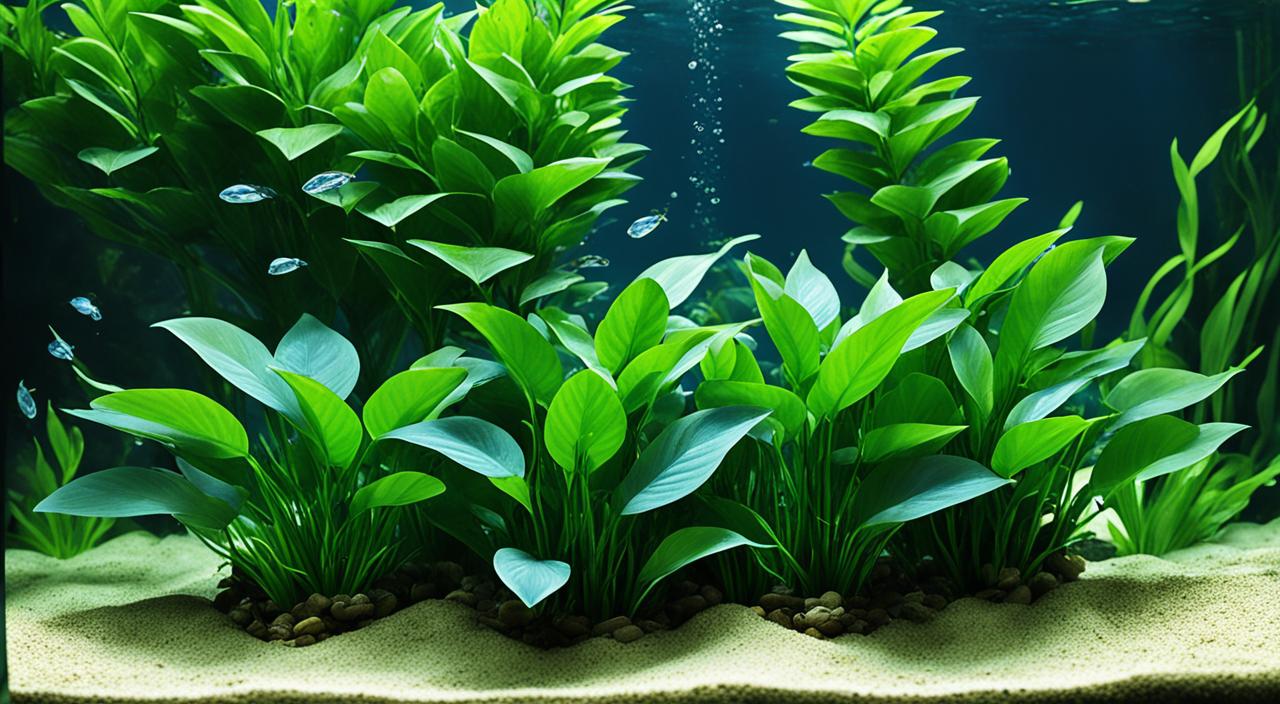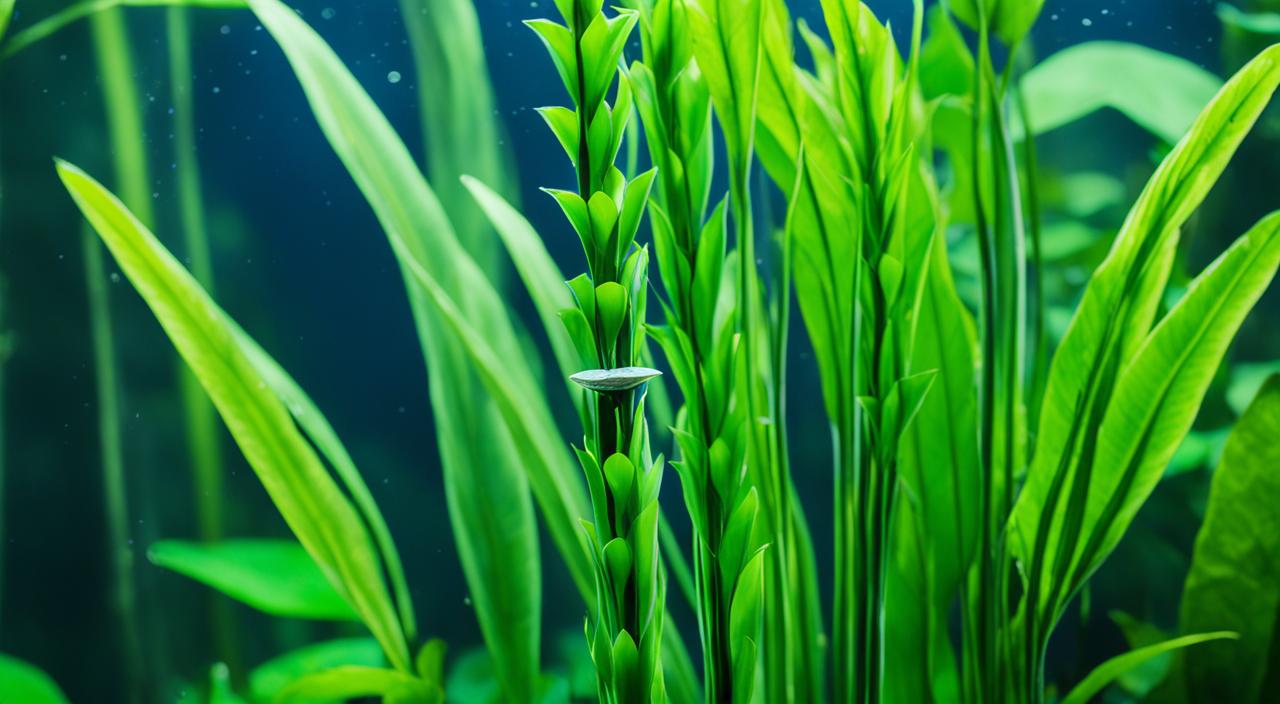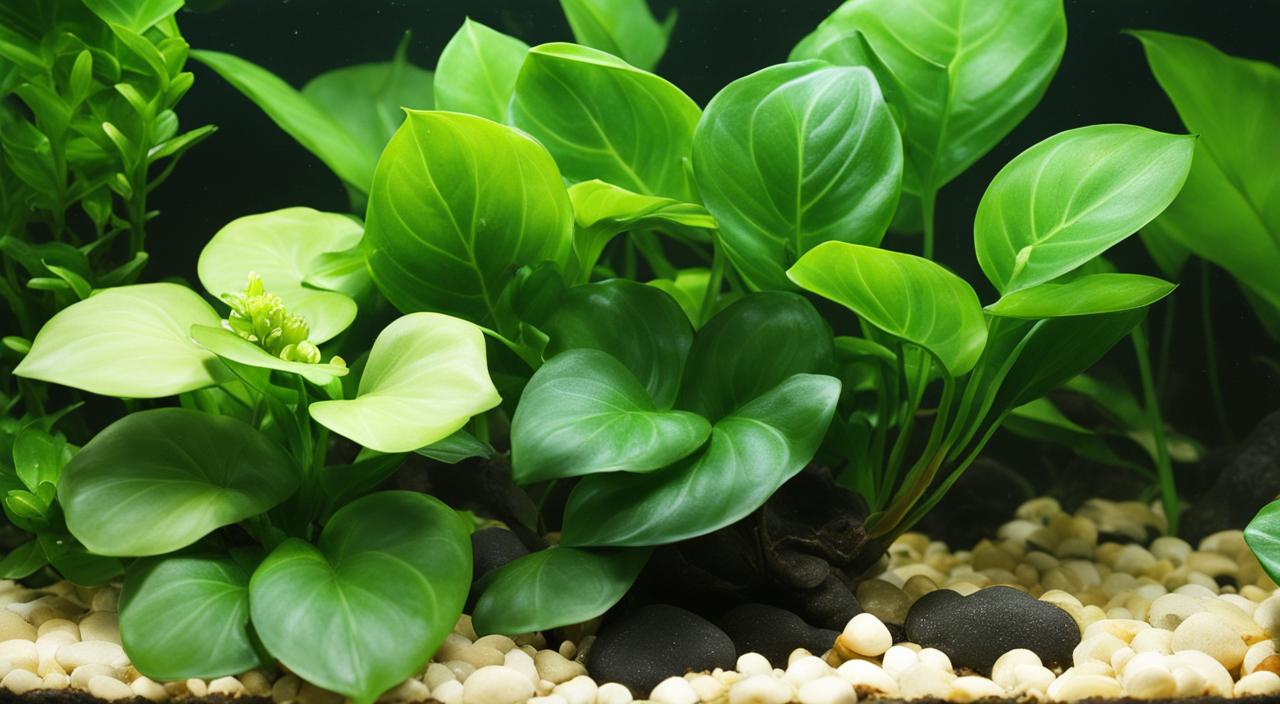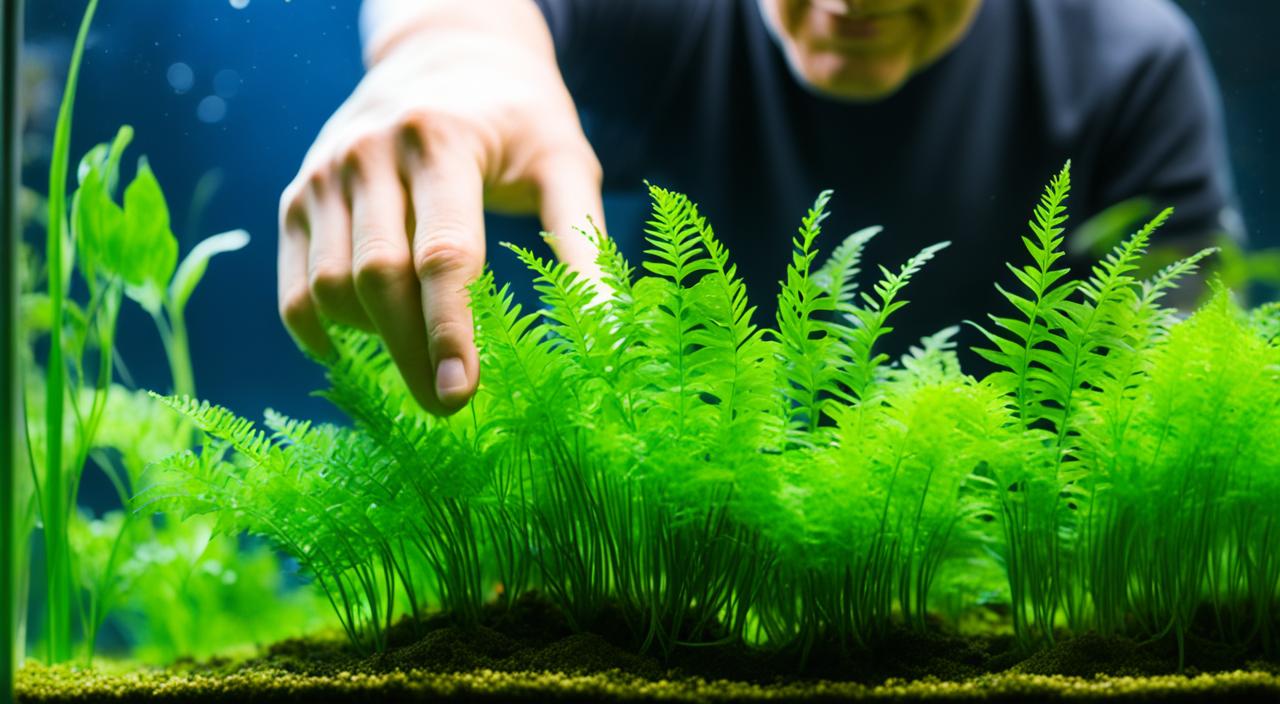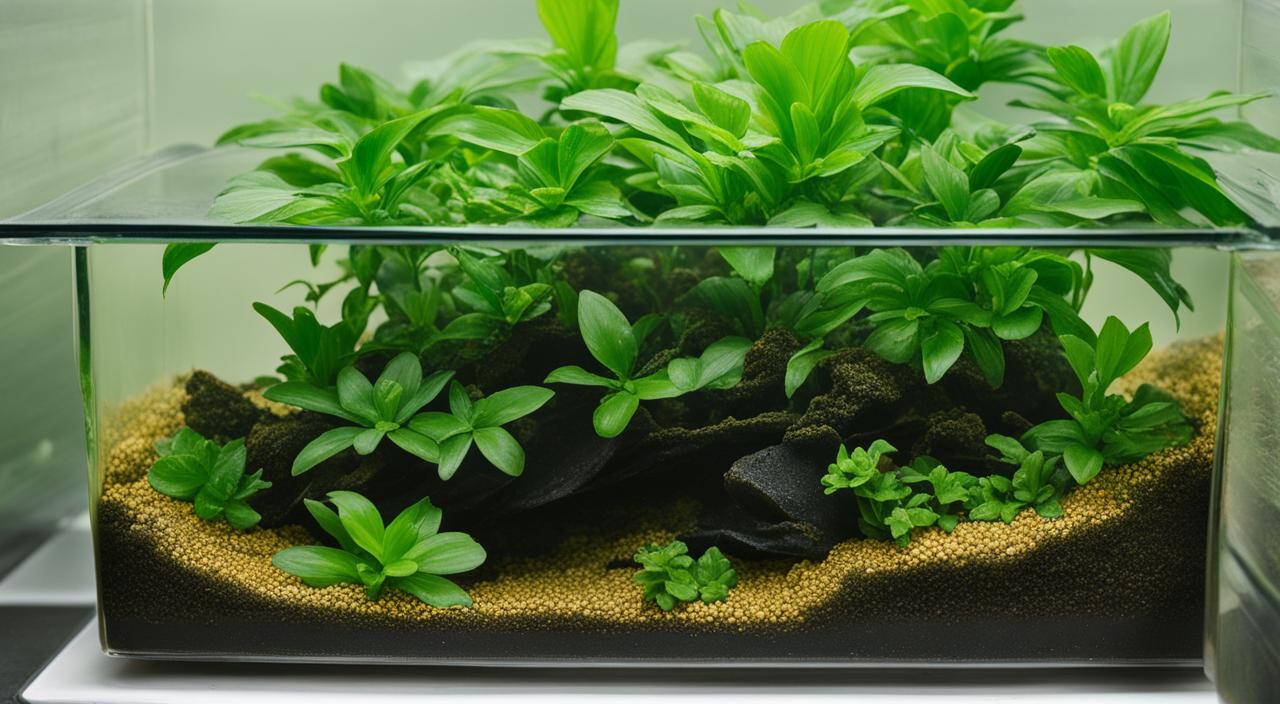Hello, fellow aquarium enthusiasts! Today, I want to introduce you to a fascinating plant that can elevate the beauty of your freshwater aquarium. Let’s dive into Anubias Lanceolata, a versatile and low-light aquatic plant that is perfect for both beginner and experienced aquarists.
Anubias Lanceolata is a freshwater aquarium plant species known for its slender and sharp leaves. Unlike other Anubias varieties, such as Anubias Barteri or Anubias Nana, this particular species stands out with its unique leaf shape. The dark green leaves have a waxy appearance, making them resistant to algae growth, and lend an elegant touch to any aquascape.
One of the significant advantages of Anubias Lanceolata is its adaptability to a wide range of water parameters. Whether you have a tropical or cold water tank, this plant can thrive in various conditions. It is commonly found in West Africa, where it naturally grows in freshwater environments such as rivers, streams, and marshes.
If you’re looking for a low-maintenance plant, Anubias Lanceolata is an excellent choice. It doesn’t require intense lighting and can withstand low-light conditions, making it perfect for aquariums with limited access to natural sunlight. In addition, it’s a hardy species that can tolerate fluctuations in water parameters, making it suitable for beginners.
To grow Anubias Lanceolata successfully, it is crucial to provide the right placement and lighting. This plant prefers to attach its rhizome, the horizontal stem from which the leaves and roots emerge, to a hard surface such as rocks or driftwood. As for lighting, low to medium intensity is sufficient for optimal growth.
Ready to learn more about Anubias Lanceolata care, propagation methods, and its compatibility with other tank mates? Let’s explore this further in this comprehensive guide.
Key Takeaways:
- Anubias Lanceolata is a low-light aquatic plant that adds elegance to freshwater aquariums.
- Its slender, sharp leaves and waxy appearance make it resistant to algae growth.
- Anubias Lanceolata is adaptable to various water parameters and can thrive in different aquatic setups.
- Proper placement, low to medium lighting, and stable water conditions are essential for its growth.
- It is a hardy and low-maintenance plant, making it suitable for beginner and experienced aquarists.
Brief Overview Of Anubias Lanceolata
Anubias Lanceolata is an undemanding and easy-to-care-for plant, making it suitable for both beginner and experienced aquarists. It can be grown in various aquarium setups, including tropical tanks. Its hardy nature and vibrant green colour make it a popular choice for aquascaping. With the proper care and conditions, Anubias Lanceolata can thrive and enhance the overall aesthetics of your aquarium.
Plant Species Table:
| Characteristic | Anubias Lanceolata |
|---|---|
| Scientific Name: | Anubias Lanceolata |
| Common Names: | Lance-leaf Anubias, Spear-leaf Anubias |
| Origin: | West Africa |
| Height: | 25-50 cm |
| Growth Rate: | Slow |
| Colour: | Dark green |
| Aquarium Placement: | Midground to Background |
| Water Type: | Freshwater |
| pH: | 6.0 – 7.5 |
| Care Level: | Easy |
| Light Requirements: | Low to Moderate (50-200 PAR, 2000-3000 lux, Kelvin scale around 6500K for optimal growth) |
| CO2 Requirements: | It is not necessary, but it can benefit from supplementation |
| Temperature: | 22°C – 28°C (72°F – 82°F) |
| Flow Rate: | Low to Moderate (tolerates a range but does not prefer strong currents) |
| Propagation: | Rhizome division (cutting the rhizome and attaching the new piece to substrate or decor) |
| Feed Type: | Not necessary, but it can benefit from supplementation. |
The light requirements for Anubias Lanceolata are pretty flexible, making it suitable for a range of aquarium setups. It can thrive under low to moderate light intensity. Providing light within the specified PAR (Photosynthetically Active Radiation) and lux values ensures that the plant receives enough sunlight for photosynthesis without exposure to excessive intensity that might promote algae growth. The recommended Kelvin scale helps simulate natural daylight conditions, promoting healthy growth.
Origins And Habitat
Anubias Lanceolata is native to West Africa and grows naturally in freshwater environments. It can be found in rivers, streams, and marshes. The plant attaches its rhizome to rocks or driftwood in its natural habitat, allowing it to anchor itself underwater. Understanding its origins and natural habitat can help aquarists replicate similar tank conditions for optimal growth.
Morphological Characteristics
Anubias Lanceolata is known for its unique morphological characteristics, which set it apart from other Anubias varieties like Anubias Barteri or Anubias Nana. One of the distinguishing features of Anubias Lanceolata is its slender and sharp leaves. Unlike the round leaves found on other Anubias plants, the leaves of Anubias Lanceolata have a distinct shape that adds visual interest to any aquarium.
These leaves are typically dark green and have a waxy appearance. This waxy coating enhances the plant’s aesthetic appeal and serves a functional purpose. The waxy coating makes the leaves resistant to algae growth, keeping them clean and vibrant.
The rhizome is another essential part of Anubias Lanceolata. The rhizome is a horizontal stem that grows beneath the substrate or attaches to rocks or driftwood. It serves as the anchor from which the leaves and roots emerge, providing stability and support for the plant.
Understanding the morphological characteristics of Anubias Lanceolata is crucial for proper care and maintenance. By recognizing the unique shape and features of its leaves and understanding the role of the rhizome, aquarists can ensure this beautiful aquatic plant’s optimal growth and health.
Placement And Lighting
Anubias Lanceolata, a popular low-light aquarium plant, requires proper placement and lighting conditions to thrive in your tank.
To ensure the optimal growth of Anubias Lanceolata, it is essential to attach its rhizome, the horizontal stem from which leaves and roots emerge, to a hard surface in your aquarium. This can be achieved by securing the plant to rocks, driftwood, or other hardscape elements using fishing lines or plant-safe adhesives.
The key to maintaining Anubias Lanceolata’s health is suitable lighting. This plant prefers low light conditions and should be protected from intense lighting, as it can lead to algae growth on its leaves. Placing Anubias Lanceolata in a shaded tank area or under low-intensity lighting can help prevent algae growth and promote the plant’s overall well-being.
| Lighting Level | Ideal Placement |
|---|---|
| Low light | In a shaded area or under low-intensity lighting |
| In the shaded area or under low-intensity lighting | In a shaded area or under low-intensity lighting |
| High light | Not recommended as it may promote algae growth |
What Are Good Tank Mates?
When selecting tank mates for your Anubias Lanceolata, choosing freshwater fish species that are compatible and can peacefully coexist with your plant is important. This will help create a harmonious and thriving aquarium ecosystem. Here are some good tank mates for Anubias Lanceolata:
Good Tank Mates
- Tetras
- Rasboras
- Livebearers
- Corydoras catfish
- Otocinclus
- Shrimp
- Snails
Many peaceful community fish like tetras, rasboras, and livebearers can coexist with Anubias Lanceolata. Bottom-dwelling species like Corydoras catfish and otocinclus can also be compatible tank mates. Additionally, introducing shrimp and snails into the tank can help maintain a balanced ecosystem without harming the plant.
Feeding (Fertilization)
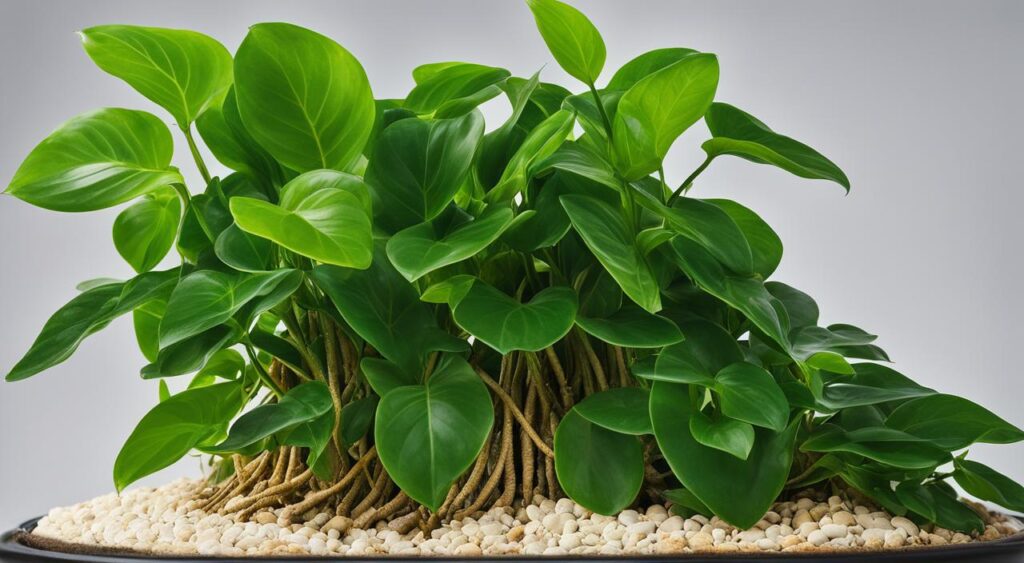
Anubias Lanceolata, an aquatic plant commonly found in freshwater aquariums, obtains nutrients from the water column. However, to promote healthy growth, it can benefit from regular fertilization. By providing essential nutrients through liquid or substrate-based fertilizers formulated specifically for aquarium plants, you can enhance the overall well-being of your Anubias Lanceolata.
The frequency and amount of fertilizer application may vary depending on the specific product and the needs of your tank. It is essential to follow the manufacturer’s instructions and consider the nutrient requirements of Anubias Lanceolata to support its optimal growth.
Feeding your Anubias Lanceolata with suitable fertilizers ensures it receives the necessary elements to thrive and maintain its vibrant appearance in your aquarium.
To visually illustrate the importance of feeding and fertilizing Anubias Lanceolata, refer to the table below:
| Nutrient | Recommended Amount | Frequency |
|---|---|---|
| Nitrogen (N) | 2 ppm | Once a week |
| Phosphorus (P) | 0.5 ppm | Once a week |
| Potassium (K) | 10 ppm | Once a week |
| Trace Elements | As directed by the manufacturer | As directed by the manufacturer |
CO2 Injection
While Anubias Lanceolata does not require CO2 supplementation, introducing CO2 into the aquarium can promote faster growth and more robust leaves. There are various methods of CO2 injection available, including pressurized CO2 systems, DIY yeast CO2 setups, and liquid CO2 alternatives. Understanding the different types of CO2 injection and their effects on plant growth can help you decide if CO2 supplementation is necessary for your tank.
Care
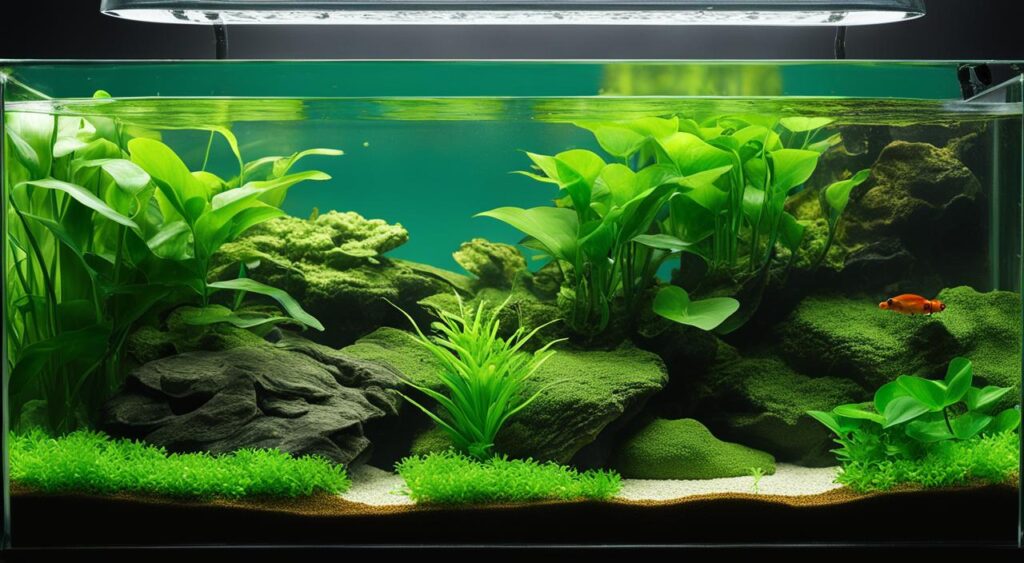
Planted Tank Parameters
Anubias Lanceolata’s care involves providing the right planted tank parameters for optimal growth and health. Maintaining stable water parameters is essential for this plant’s well-being. Here are the recommended ranges for critical parameters:
| Parameter | Ideal Range |
|---|---|
| pH | 6.0 to 9.0 |
| Temperature | 72°F to 82°F (22°C to 28°C) |
| Hardness (dKH) | 2 to 10 |
Monitoring and maintaining these parameters within the recommended ranges will create an environment conducive to the growth and well-being of Anubias Lanceolata.
Water Quality
High-quality water is crucial for the health and vitality of Anubias Lanceolata. Regular water testing is essential to ensure optimal conditions for the plant. Testing parameters such as temperature, pH, ammonia, nitrite, and nitrate levels can help identify any imbalances or issues that may affect the plant. Use reliable water test kits or test strips to monitor these parameters and make necessary adjustments to maintain an optimal environment for your aquatic plants.
Filtration
Aquarium filtration plays a significant role in maintaining water quality and creating a healthy environment for Anubias Lanceolata. A sound filtration system helps remove waste, excess nutrients, and toxins from the water. It also promotes water circulation, essential for nutrient distribution and oxygenation. Choose a filter that suits the size of your aquarium and provides adequate mechanical, chemical, and biological filtration.
Flow
Proper water flow is vital for Anubias Lanceolata’s growth and development. Gentle to moderate water flow is preferred, as excessive flow can damage the delicate leaves and roots. Avoid placing the plant directly in the path of strong water currents. It’s advisable to position it in areas with gentle water movement or use hardscape elements like rocks and driftwood to create barriers that help redirect the flow and protect the plant.
Aquarium Maintenance
Testing Water Conditions
Regularly testing water conditions is essential to maintaining a healthy environment for Anubias Lanceolata in your aquarium. By monitoring key parameters such as temperature, pH, ammonia, nitrite, and nitrate levels, you can ensure that the water quality is optimal for the plant’s growth and well-being.
Water test kits or test strips are convenient tools that enable you to assess different water parameters accurately. These kits typically provide clear instructions on using them and interpreting the results. Following the manufacturer’s recommended testing frequency based on your specific aquarium setup is best.
How to Set Up Your Aquarium Tank
Properly setting up your aquarium tank is crucial for creating a suitable habitat for Anubias Lanceolata. Here are some essential steps to follow:
- Start by thoroughly cleaning the tank and equipment, including the substrate, gravel, decorations, and filtration system.
- Add an appropriate substrate to the bottom of the tank. Anubias Lanceolata can grow in various substrate types, such as gravel, sand, or specialized aquatic plant substrates, but it prefers a nutrient-rich substrate.
- Install the filtration system in accordance with the manufacturer’s instructions. Proper filtration helps maintain water quality by removing impurities and providing oxygenation.
- Fill the tank with dechlorinated water, ensuring that the water temperature matches the desired range for Anubias Lanceolata.
- Position any hardscape elements, such as rocks or driftwood, in the tank. These structures will serve as anchor points for attaching the Anubias Lanceolata rhizome later.
Anubias Lanceolata can be a great centrepiece or background plant in your aquarium, so consider its placement and how it will complement other aquatic plants and decorations in your aquascape.
Propagation Methods
Propagating Anubias Lanceolata is relatively straightforward, making it an excellent choice for plant enthusiasts. Here are two standard propagation techniques:
- Rhizome Division: Gently separate the rhizome into individual sections, ensuring that each segment has healthy leaves and roots attached. Plant the divided sections in suitable substrates or attach them to hardscape elements in your aquarium.
- Leaf Cuttings: Cut a healthy leaf from the plant near the rhizome using clean scissors or a sharp knife. Ensure that the cutting includes a portion of the rhizome. Plant the leaf cutting in the substrate or attach it to hardscape elements using a fishing line or plant-safe adhesives.
Both methods offer the opportunity to propagate and expand your Anubias Lanceolata collection or share it with fellow aquarists. The new plants will grow and flourish in your aquarium with proper care.
Health And Disease
Ensuring the health of Anubias Lanceolata is crucial for its growth and overall well-being in your aquarium. By understanding the signs of good and poor health, joint health issues and plant pests that can affect this species, you can take proactive measures to keep your Anubias Lanceolata thriving.
Signs Of Good Health
- Vibrant green leaves
- New growth and development of leaves
- No signs of damage or discoloration
When your Anubias Lanceolata exhibits these signs, you can be confident that it is healthy. These visual cues indicate that the plant receives adequate nutrients, light, and care.
Signs Of Poor Health
- Wilting or yellowing leaves
- Stunted or no new growth
- The presence of brown spots or holes on the leaves
- Algae growth on the plant surface
- Root rot or decay
If you notice any of these signs, addressing the underlying issues promptly is essential to prevent further deterioration of the plant’s health.
Common Health Issues And Treatment
Anubias Lanceolata can be susceptible to various health issues, including:
| Health Issue | Treatment |
|---|---|
| Brown or Black Spots on Leaves | Trim affected leaves and improve water circulation to prevent bacterial or fungal growth. |
| Root Rot | Remove affected portions of the root and replant the healthy sections. Ensure proper water flow and avoid overwatering. |
| Algae Growth | Maintain appropriate light levels, nutrient balance, and regular tank maintenance to control algae growth. Consider adding algae-eating fish or snails as natural control. |
| Deficiencies in Nutrients | Supplement the necessary nutrients through liquid or substrate-based fertilizers formulated for aquarium plants. Adjust fertilization based on plant requirements and water test results. |
Identifying the issue and taking corrective measures early can help restore the plant’s health and prevent further complications.
Plant Pests
Despite being hardy, Anubias Lanceolata can still attract certain plant pests. The typical plant pests that may affect this species include:
- Snails
- Algae-eating shrimp
To control these pests, you can manually remove them from the plant or introduce natural predators like fish or other shrimp species that feed on snails and algae.
Summary
Anubias Lanceolata is a popular and easy-to-care-for plant that can thrive in freshwater aquariums. With its slender and sharp leaves, as well as its unique rhizome structure, it adds an attractive touch to any aquascape. By providing the right conditions and care, you can ensure the optimal growth of Anubias Lanceolata in your aquarium.
A critical aspect of caring for Anubias Lanceolata is to provide it with low to medium light. The plant prefers not to be exposed to intense lighting, as it can promote algae growth on its leaves. Placing it in a shaded tank area or under low-intensity lighting is ideal for maintaining its health and preventing algae growth.
Additionally, it’s crucial to maintain stable water parameters and provide regular fertilization for the plant. Anubias Lanceolata can benefit from liquid or substrate-based fertilizers formulated specifically for aquarium plants. By following the manufacturer’s instructions and considering the plant’s nutrient requirements, you can support healthy growth.
Lastly, it’s essential to consider the tank mates and overall tank conditions for Anubias Lanceolata. This plant can coexist with many peaceful community fish species, such as tetras, rasboras, and livebearers. Avoiding aggressive tank mates is crucial to prevent damage to the plant. Maintaining suitable tank conditions, including proper filtration and water flow, further promotes a healthy environment for Anubias Lanceolata.
FAQ
What are the care requirements for Anubias Lanceolata?
Anubias Lanceolata is an easy-to-care-for plant that can thrive in a wide range of water parameters. It requires low to medium light, regular fertilization, and can benefit from CO2 supplementation for faster growth.
Where is Anubias Lanceolata native to?
Anubias Lanceolata is native to West Africa, where it grows naturally in freshwater environments such as rivers, streams, and marshes.
How are the leaves of Anubias Lanceolata different from other Anubias varieties?
Anubias Lanceolata has slender and sharp leaves, which are different from the round leaves of other Anubias varieties like Anubias Barteri or Anubias Nana.
Where should I place Anubias Lanceolata in my aquarium?
Anubias Lanceolata should be placed in a tank where its rhizome can be attached to a hard surface such as rocks or driftwood. This plant prefers low light conditions and should be placed in a shaded area or under low-intensity lighting.
What are some suitable tank mates for Anubias Lanceolata?
Many peaceful community fish like tetras, rasboras, and livebearers can coexist with Anubias Lanceolata. Bottom-dwelling species like Corydoras catfish and otocinclus can also be compatible tank mates. Shrimp and snails can be introduced without harming the plant.
How often should I fertilize Anubias Lanceolata?
Anubias Lanceolata can benefit from regular fertilization with liquid or substrate-based fertilizers formulated for aquarium plants. The frequency and amount of fertilizer application depend on the specific product and the needs of your tank.
Is CO2 supplementation necessary for Anubias Lanceolata?
Anubias Lanceolata does not require CO2 supplementation, but it can promote faster growth. Various methods of CO2 injection can be used, including pressurized CO2 systems, DIY yeast CO2 setups, and liquid CO2 alternatives.
What are the ideal tank parameters for Anubias Lanceolata?
Anubias Lanceolata thrives in stable water parameters with a pH range of 6.0 to 9.0, a temperature between 72°F to 82°F (22°C to 28°C), and a hardness level between 2 to 10 dKH.
How do I maintain the health of Anubias Lanceolata?
Regularly test and monitor water parameters such as temperature, pH, ammonia, nitrite, and nitrate levels. Provide stable water conditions, proper filtration, and adequate flow in the aquarium. Avoid excessive algae growth and maintain proper nutrient levels for the plant’s health.
How do I propagate Anubias Lanceolata?
Anubias Lanceolata can be propagated by cutting or pulling apart the rhizomes. Ensure each propagated section has sufficient roots and attach them to a hard surface in the same manner as the parent plant.
What are the signs of good health in Anubias Lanceolata?
Signs of good health in Anubias Lanceolata include vibrant green leaves, new growth and development of leaves, and no signs of damage or discoloration.
What are some common health issues and diseases that can affect Anubias Lanceolata?
Anubias Lanceolata is generally resistant to diseases, but it can be susceptible to algae growth if exposed to intense lighting. Common plant pests like snails and algae can also be a concern.
How do I set up and maintain my aquarium for Anubias Lanceolata?
When setting up your aquarium, ensure the substrate is suitable for anchoring the plant’s rhizome. Provide proper lighting, stable water conditions, and regular maintenance, including water testing and required nutrient supplementation. Proper tank filtration and flow are also essential for the plant’s health.
What are the key points to remember for Anubias Lanceolata care?
Anubias Lanceolata is an easy-to-care-for plant that thrives in low to medium light conditions. It can be attached to a hard surface in the aquarium and benefits from regular fertilization. CO2 supplementation is not necessary but can promote faster growth. Provide stable water parameters, suitable tank mates, and proper maintenance for optimum growth and health of the plant.

